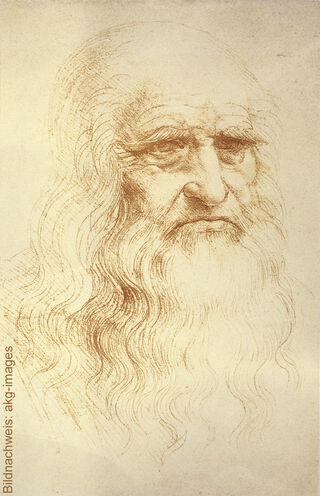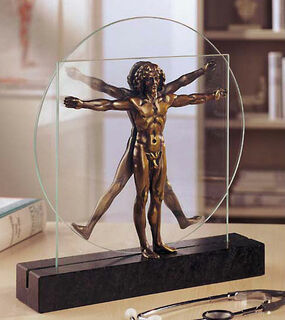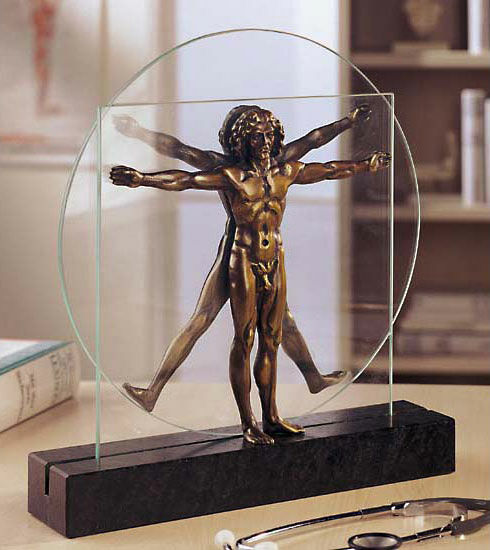Sculpture"Schema delle Proporzioni", bronze version
Sculpture"Schema delle Proporzioni", bronze version
Quick info
ars mundi Exclusive Edition | bronze + glass + diabase | handmade | hand-patinated | polished | size 30 x 32 x 7 cm
Detailed description
Sculpture"Schema delle Proporzioni", bronze version
Leonardo da Vinci's famous pen and ink drawing from one of his legendary notebooks have become a worldwide trademark for progress, science and medicine. His anatomy study as a three-dimensional work of art, exclusively at ars mundi. Outstandingly hand-cast using the Lost-Wax-Process and mounted on a diabase pedestal with cut glass. Edition in fine bronze. Patinated and polished by hand. Size 30 x 32 x 7 cm.

About Leonardo da Vinci
1452-1519
Leonardo da Vinci is considered the greatest universal genius in the history of art and science. His inventions, works of art and studies, but not forgetting his mysterious life, continue to interest science and literature to this day.
The universal genius Leonardo da Vinci, the epitome of the Renaissance man, was a painter, sculptor, builder, writer, art theorist, naturalist, inventor and technician all in one. Even though in primary school the illegitimate child had barely learned how to read, write and do arithmetic, thanks to his unique talent, he soon set himself up early for an apprenticeship as a painter and sculptor with Andrea del Verrocchio and tried to gain employment at one of the courts. Temporarily he succeeded in working for the Duke of Milan or Cesare Borgia, the Pope or the French King.
His life was filled with the study of humanities and the universal urge for knowledge and action that was characteristic of his epoch. Through incessantly observing, recording and analysing, he created a huge oeuvre as a scientist and technician alone. For example, he studied the geological formation and cloud formation, the flow of water and air, the flight of birds and apparatus in order to enable human flight.
His work as a visual artist, on the other hand, is smaller but occupies a very high rank, such as the "Last Supper" or the "Mona Lisa".
His artistic striving for compositions with moderately calm geometric basic forms prepared for the High Renaissance. His later approaches to grasping the world of appearance in its transformation through air and light even point ahead to Baroque painting.
An alloy of copper with other metals (especially with tin) used since ancient times.
When casting bronze, the artist usually applies the lost-wax technique which is dating back more than 5000 years. It's the best, but also the most complex method of producing sculptures.
First, the artist forms a model of his sculpture. It is embedded in a liquid silicone rubber mass. Once the material has solidified, the model is cut out. The liquid wax is poured into the negative mould. After cooling down, the wax cast is removed from the mould, provided with sprues and dipped into ceramic mass. The ceramic mass is hardened in a kiln, whereby the wax flows out (lost mould).
Now we finally have the negative form, into which the 1400° C hot molten bronze is poured. After the bronze had cooled down, the ceramic shell is broken off and the sculpture is revealed.
Now the sprues are removed, the surfaces are polished, patinated and numbered by the artist himself or, to his specifications, by a specialist. Thus, each casting becomes an original work.
For lower-quality bronze castings, the sand casting method is often used which, however, does not achieve the results of a more complex lost-wax technique in terms of surface characteristics and quality.
Graphic or sculpture edition that was initiated by ars mundi and is available only at ars mundi or at distribution partners licensed by ars mundi.
(Rebirth). The term describing art from around 1350 until the 16th century.
A mindset that developed in Florence in the late 14th century that was retrospectively classified as rebirth of the classical ideals of Greek and Roman antiquity. During the 15th and 16th centuries, the Renaissance spread first over Italy and then all over Western Europe and determined the entire artistic creation. Brilliant artists such as Donatello, Leonardo da Vinci, Michelangelo, Raphael, Dürer, Holbein, Cranach and Fouquet created their immortal works by following the humanistic premises and placing the human being in the centre of all thinking.
Renaissance experienced its heyday in literature through dramatic works and poems of William Shakespeare.
At the end of the 16th century, the Renaissance had to give way to the opulence of baroque, before its ideas experienced a rebirth in the classicism of the 18th century.
A plastic work of sculptural art made of wood, stone, ivory, bronze or other metals.
While sculptures from wood, ivory or stone are made directly from the block of material, in bronze casting a working model is prepared at first. Usually, it is made of clay or other easily mouldable materials.
The prime time of sculpture after the Greek and Roman antiquity was the Renaissance. Impressionism gave a new impulse to the sculptural arts. Contemporary artists such as Jorg Immendorf, Andora, and Markus Lupertz also enriched sculptures with outstanding works.


